

Five Personalized Learning Myths and What You Can Do to Overcome Them – Paul Emerich France. There are a number of myths surrounding personalized learning, and it wasn’t until I moved to San Francisco and worked for an education technology start-up for three years that I learned about them by experiencing them first-hand.

These myths are pervasive, but it turns out that if we’re aware of them, we can use the our most powerful tool of all–our pedagogy–to overcome them and do right by our students. Myth 1: Personalization necessitates an individualized curriculum. If personalization and individualization were supposed to mean the same thing, they wouldn’t be two different words. In order to understand the difference between the two, just examine the bases of the words. The base of personalization is person, while the base of individualization is div or divid, meaning “separate.” When we individualize, we separate: we isolate students by giving each of them their own curriculum. Myth 2: Personalized learning means that curriculum must be interest-based. The solution, you ask? High-Tech Personalized Learning Without All the Screentime? It’s Happening in Georgia.
“Is it going to explode?”
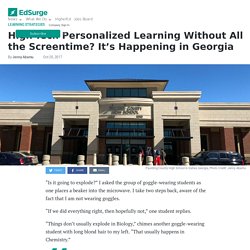
I asked the group of goggle-wearing students as one places a beaker into the microwave. I take two steps back, aware of the fact that I am not wearing goggles. “If we did everything right, then hopefully not,” one student replies. “Things don’t usually explode in Biology,” chimes another goggle-wearing student with long blond hair to my left. “That usually happens in Chemistry.” Beware the Iconography Trap of Personalized Learning: Rigor Matters. This is the first in our series of "Notes From The Field" on personalized learning.
My colleague and I recently visited a middle school science classroom. Students, outfitted with safety glasses, were organized into groups of three to four. The room was lively but not disorderly as each group worked on its own experiment. Digital badging spreads as more colleges use vendors to create alternative credentials. Digital badges aren’t replacing the bachelor’s degree any time soon.

But a growing number of colleges are working with vendors to use badges as an add-on to degrees, to help students display skills and accomplishments that transcripts fail to capture. Illinois State University is an early adopter. Students in the university’s honors program have earned roughly 7,400 digital badges as part of the experiment, which just began at full scale last year. The university brought in Credly, a badging platform provider, for the project. Administrators at Illinois State said the badges serve as a form of verified “three-dimensional transcript,” which augments the traditional degree.
“It’s a way for them to organize all of their experiences, all of the skill sets they learn,” said Rocio Rivadeneyra, the honors program’s interim director. Personalized Perspective. Delivering the best learning experience to each and every student.
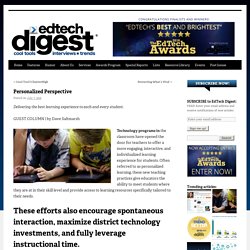
GUEST COLUMN | by Dave Saltmarsh Technology programs in the classroom have opened the door for teachers to offer a more engaging, interactive, and individualized learning experience for students. The Changing Role Of The Teacher In Personalized Learning Environment. Racially diverse 'new majority' set to reshape US public schools. America’s public schools are a snapshot of a changing America: Since 2014, for the first time in the country’s history, a majority of those in public schools have been students of color.
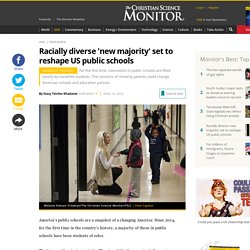
That’s more than just a statistic. The rise of this “new majority” promises to have sweeping effects on American schools over time. The voices and interests of these students and their parents will need to be better woven into the decisionmaking that affects United States classrooms, many education experts say. 4 Positives From Personalized Learning. We’ve finished the first iteration of trying to move my 10th grade English courses to become more personalized.
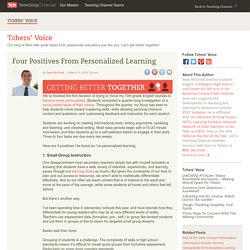
Students concluded a quarter-long investigation of a social justice issue of their choice. Throughout the quarter, my focus has been to help students move toward mastering skills, while allowing personal choice in content and questions, and customizing feedback and instruction for each student. Students are working on reading informational texts, writing arguments, speaking and listening, and creative writing. Most class periods begin with a 15-20 minute mini-lesson and then students go to a self-selected station to engage in their work.
Three to four tasks are due every two weeks. When Buzzwords Get Muddy: Defining 'Personalized Learning' Personalized learning—as a turn of phrase, a philosophy, and an ambition for our students—is gaining momentum nationwide.
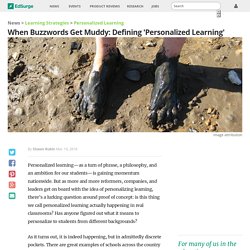
But as more and more reformers, companies, and leaders get on board with the idea of personalizing learning, there’s a lurking question around proof of concept: is this thing we call personalized learning actually happening in real classrooms? Has anyone figured out what it means to personalize to students from different backgrounds? As it turns out, it is indeed happening, but in admittedly discrete pockets. The Adoption of Personalized Learning Infographic. Other Infographics The Adoption of Personalized Learning Infographic The Adoption of Personalized Learning Infographic Personalized learning is the most effective style of teaching.

That’s according to the majority of the educators who participated in a survey on the topic. The attributes that make it effective include higher student engagement, the ability for students to work at their own pace, and the opportunity to focus on students’ weaker subject areas. The Changing Role Of The Teacher In Personalized Learning Environment. Facebook's Zuckerberg to Bet Big on Personalized Learning. Personalized Learning Playbook. Personalized learning means different things to different people.
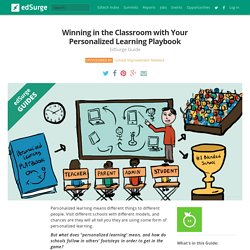
Visit different schools with different models, and chances are they will all tell you they are using some form of personalized learning. But what does “personalized learning” mean, and how do schools follow in others' footsteps in order to get in the game? When it comes to sports, players turn to the playbook. Teams start by following a set of strategies that are tried and true, tested over decades of playing the game. (Take the play-action pass, or the pick-and-roll, for example!) Which Personalized Learning Framework is Best For You and Your School? Early in my teaching career I taught eighth and ninth grade English in a small classroom that had nothing more than a chalkboard, ceiling fan, and about twenty-five attentive pairs of eyes looking up at me for guidance five hours each day. One simple retention technique I used regularly was to “personalize” my examples for vocabulary, grammar, etc. with the names of students from the class and local context.
No one cared about Jonny in our grammar workbooks, but they did care about the crazy, unpredictable examples I would come up with using people and things we knew. And if you would have asked me or my students about their experience, everyone would have naively told you, “Yes, Mr.